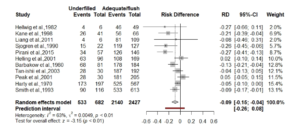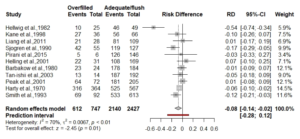
Root canal treatment (RoCT) outcome can only be assessed through case follow-up and the quality of the RoCT may influence outcome. Periapical radiography is used to assess both obturation density and working length in conjunction with apex locators. There is no consensus regarding the ideal obturation length but 2mm away from the radiographic has been considered acceptable.
This systematic review set out to identify if there was an association between obturation extent and final treatment outcome.
Methods
The systematic review followed the Preferred Reporting Items for Systematic Reviews and Meta-Analyses (PRISMA) Checklist and registered the protocol with the Prospective Register of Systematic Reviews (PROSPERO). The primary outcome was the association between RCT outcome and obturation extent. Two authors screened the following databases: Latin American and Caribbean Health Sciences (LILACS), LIVIVO, PubMed, Scopus, Web of Science, and grey literature up to October 2017. Outcomes were calculated as odds ratios. Risk of bias was assessed using The Meta-Analysis of Statistics Assessment and Review Instrument (MAStARI) for cohort studies.
Results
- 22 studies were included into the final evaluation with 11 used in the meta-analysis (Table 1.).
- The RoB assessment classified two studies as high RoB, seven as moderate, and thirteen as low.
| Underextended obturations | Summary estimate (OR) | 95% Confidence interval |
| At apex | 5.67 | 2.07 to 15.52 |
| 1mm underextended | 1.73 to 7.67 | (1.0 to 2.9) to (0.9 to 60.2) |
| 2mm underextended | 0.93 to 6.94 | (0.5 to 1.6) to (22 to 21.9) |
| 3mm underextended | 4.26 | 2.10 to 8.70 |
| Overextended obturations | 0.72 to 23 | (0.3 to1.7) to (5.6 to 94.7) |
Table 1. Summary estimates of under/overextended obturation.
Conclusions
The authors concluded: –
Obturation extent seems to influence RCT outcome; overextended and underextended obturations showed higher chance of association with less favourable outcomes than adequate obturation; however, this association was not categorically supported.
Comments
This was a well-constructed systematic review following PRISMA guidelines and with a pre-registered protocol.
The meta-analysis was however unclear for a couple of reasons. Firstly, there is no justification in the methods section for the use of odds ratios, which are difficult to interpret and should be limited to case-control studies for clarity. Secondly the authors used a fixed effects model on what were quite heterogeneous studies, and their subgroup analysis but did not provide a summary estimate. Below I have recalculated the results using risk difference and a random effects model. (Fig 1-2)
Figure 1. Forest plot of underfilled obturation.
Figure 2. Forest plot of overfilled obturation.
From this reworked analysis it is still possible to derive the same conclusions in a clearer format. From the summary estimates we see similar weak (8% to 9%) but significant reductions in outcome if the RCT was over or underfilled. The prediction interval crosses the line of null effect for future studies.
Links
Primary Paper
Mello FW, Miguel AFP, Ribeiro DM, Pasternak B Jr, Porporatti AL, Flores-Mir C,Andrada AC, Garcia LDFR, Dutra-Horstmann KL. The influence of apical extent of root canal obturation on endodontic therapy outcome: a systematic review. Clin Oral Investig. 2019 May;23(5):2005-2019. doi: 10.1007/s00784-019-02897-x. Epub2019 Apr 17. Review. PubMed PMID: 31001687


